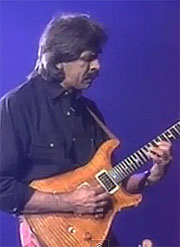Written and originally recorded in the early ’70s, Guajira is the classic example of a Santana song that is — at first examination — very simple. However, in true Santana style, that simplicity is deceptive.
Based on a traditional Latin progression, i (minor) to V7 (dominant seven), Guajira has little harmonic complexity at the core. But the arrangement adds a finesse to the simple chord progression that helps to keep the song interesting.
Instrumentation consists of bass and piano driving the chordal structure, while percussion plays an important role in the rhythm. Ostensibly a cha cha, it is augmented by the vital touches of timbalero Jose “Chepito” Areas into a funky driving groove. Rhythmically, the guitar is very sparse, and in fact doesn’t appear through most of the song.
Starting with the chorus, the vocal melody is simple and repetitive, as are the lyrics. Yet there’s something compelling about the phrasing, which adds a weight to the song beyond what might be expected.![]()
Studio vs. Live Versions
The studio version on Santana III is a bit raw, with the gang vocal in the chorus set off by a solo voice in the verse. On the best known live version (Sacred Fire, Live in South America), the entire song is song is a group chant, with the only solo voice carrying the “response” improvisation in the chorus. Ironically, the vocals are much smoother and more polished on the live version.
In the studio, the first solo is a piano — which is also the case on the later live version. But the difference in the pianists is substantial. The solo on the classic version, by Mario Ochoa, is a much simpler than the jazzy powerhouse performance played by Chester Thompson in 1993. In addition, Chester comps much of the original montuno (rhythm vamp on the piano), but tightens it up and adds some brightness to it.
Guitar Solos — Then and Now
Originally, the 2nd solo begins with a trumpet (which doesn’t appear on the later version). On Sacred Fire, however, the 2nd solo is a split between Jorge Santana (1st half), and Carlos Santana (2nd half). Both their playing styles and tones are similar, but distinct.
(Interesting note: Jorge starts his solo by hitting the notes “C#” and “E#” (“F”). Since the song is in A minor, the C# is completely out of the key. It’s possible that he meant to play “C” and “E,” — a more natural choice — and simply landed one fret higher. However, if it was an accident, it was a fortunate one, as it makes a striking intro to his solo. See photo at right.)
Live, the rhythm is changed to a 6/8 when Carlos begins his solo, then back to 4/4 before he finishes — a nice dramatic touch. After a return to the chorus, Carlos takes the 3rd solo by himself.
The original version features some desultory riffing by Carlos and maybe Neal Schon, before fading out. All in all, the later, live version is a much more powerful one, and has become a crowd pleaser for the band.![]()
Guajira Lyrics
Vamonos guajira, vamos a bailar
Que lo que quieres guajira
Si tu quieres bailar
Yo te agarro la mano
Y vamos a bailar
Que lo que quiere guajira
Si tu quieres bailar
Ven ve len, ven ve len, ven ve len ve
Y vamos a gozar
English Translation

Let’s go, girl, let’s dance
Whatever you want, girl
If you want to dance
I’ll hold your hand
And we’re going to dance
Whatever you want, girl
If you want to dance
Come on!
Guajira Chords
Verse and Chorus
Am – E7 (repeat)

